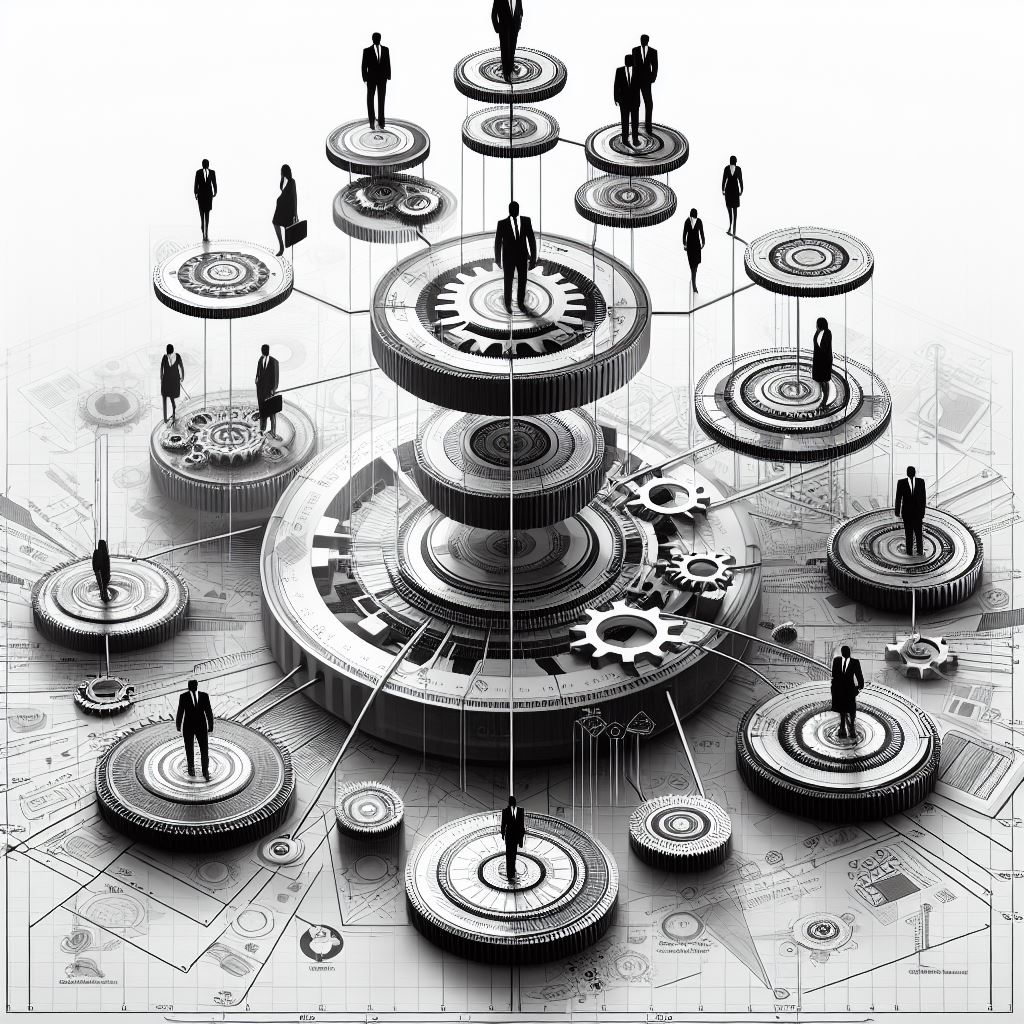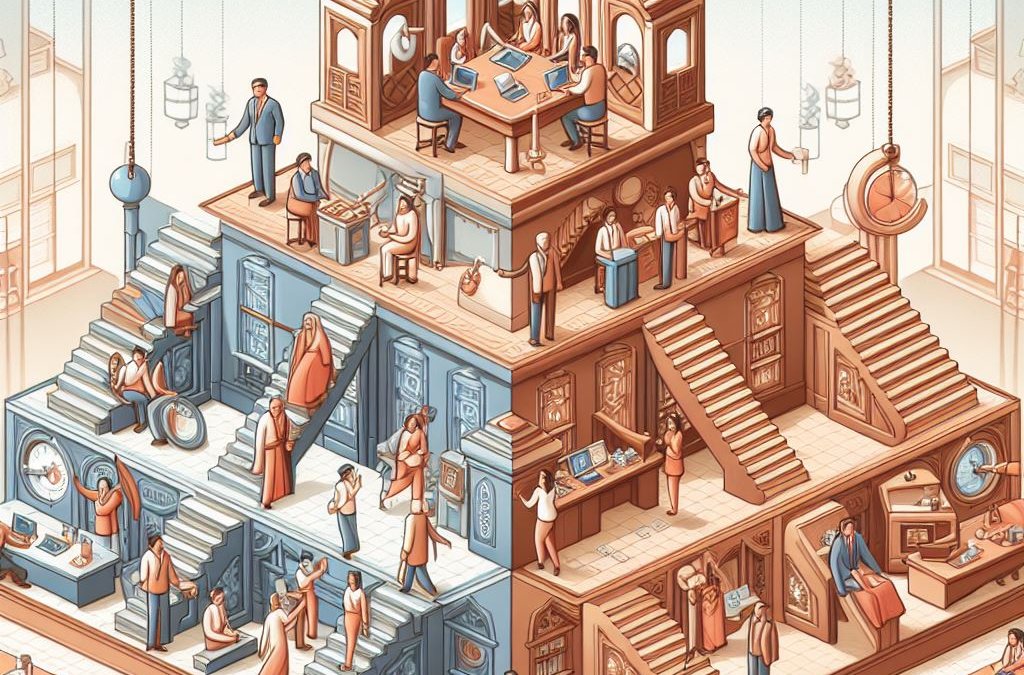الهيكل التنظيمي التقليدي مقابل الهيكل التنظيمي الحديث

استكشاف التكنولوجيا - مقدمة
19 ديسمبر 2023
من الضغوط إلى التقدم: ضرورة تقييم نضج الابتكار
23 ديسمبر 2023
يلعب الهيكل التنظيمي دورًا حيويًا في تشكيل عمل ونجاح أي عمل تجاري. مع مرور الوقت، تطور مفهوم الهيكل التنظيمي، وانتقل من الأساليب التقليدية إلى أطر أكثر حداثة ومرونة. في هذه المقالة، سنتعمق في الاختلافات الرئيسية بين الهياكل التنظيمية التقليدية والحديثة، واستكشاف خصائصها ومزاياها وتأثيراتها على الشركات.
إذا كنت تريد أن تعرف المزيد عن أهمية الهيكل التنظيمي وأنواعه وما إلى ذلك، اقرأ فهم الهيكل التنظيمي: مقدمة.
الهيكل التنظيمي التقليدي:
تقليديا، كانت المنظمات تتبع هيكلا هرميًا يؤكد على التواصل والتحكم الرأسي. وكان هذا الهيكل يتميز بمستويات متعددة من الإدارة بأدوار ومسؤوليات محددة بوضوح. وكانت سلطة اتخاذ القرار تقع بشكل أساسي في أعلى التسلسل الهرمي، مما أدى إلى خلق بيئة صارمة وبيروقراطية في بعض الأحيان. وفي مثل هذه الهياكل، كان الموظفون يتمتعون باستقلالية محدودة وكان من المتوقع أن يلتزموا بشكل صارم بالإجراءات القياسية.
مزايا الهيكل التنظيمي التقليدي:
- التسلسل الهرمي وخطوط التقارير الواضحة: يوفر الهيكل التقليدي خطوطًا واضحة للسلطة، مما يتيح التواصل واتخاذ القرارات بكفاءة.
- وضوح الأدوار: يتمتع الموظفون بأدوار محددة جيدًا، مما يقلل من الغموض ويضمن المساءلة.
- التخصص والخبرة: يسمح الهيكل الهرمي بتطوير المهارات والمعرفة المتخصصة داخل الأقسام الوظيفية.
حدود الهيكل التنظيمي التقليدي:
- بطء عملية اتخاذ القرار: غالبًا ما يؤدي الهيكل الهرمي إلى إطالة عملية الموافقة، مما يؤدي إلى إبطاء العمليات.
- الافتقار إلى المرونة: إن الطبيعة الجامدة للهياكل التقليدية تعوق القدرة على التكيف مع ظروف السوق المتغيرة أو متطلبات العملاء.
- تمكين الموظفين بشكل محدود: يتمتع الموظفون بسلطة محدودة في اتخاذ القرار، مما يحد من الابتكار والإبداع.
الهيكل التنظيمي الحديث:
إن الهياكل التنظيمية الحديثة مصممة لمعالجة القيود التي تفرضها الأساليب التقليدية مع تعزيز المرونة والتحسين المستمر. وتعطي هذه الهياكل الأولوية للتعاون والتواصل والعمل الجماعي بين مختلف الوظائف. كما تشجع على تمكين الموظفين واستقلاليتهم وتسلسل هرمي أكثر تسطحًا، مما يقلل من البيروقراطية غير الضرورية. وتهدف الهياكل الحديثة إلى تحسين الكفاءة مع توفير بيئة مواتية للإبداع والقدرة على التكيف.
خصائص الهيكل التنظيمي الحديث:
- التسلسل الهرمي المسطح: تعمل الهياكل الحديثة على تقليل عدد المستويات الهرمية، مما يعزز التواصل المباشر واتخاذ القرارات بشكل أسرع.
- فرق متعددة الوظائف: بدلاً من الأقسام المنعزلة، تؤكد الهياكل الحديثة على التعاون والفرق متعددة التخصصات لتشجيع حل المشكلات بشكل شامل.
- اتخاذ القرارات بشكل لامركزي: يتم توزيع سلطة اتخاذ القرار على مختلف مستويات المنظمة، مما يعمل على تمكين الموظفين وتعزيز الابتكار.
- أدوار ومسؤوليات مرنة: تسمح الهياكل الحديثة للموظفين بتولي أدوار ومسؤوليات متعددة، مما يعزز تنمية المهارات والتنوع.
- التركيز على التواصل والشفافية: تعد خطوط الاتصال المفتوحة وتبادل المعلومات الشفافة مكونات حيوية للهياكل الحديثة، مما يشجع على مشاركة الموظفين والتوافق.
مميزات الهيكل التنظيمي الحديث:
- المرونة والقدرة على التكيف: إن التسلسل الهرمي المسطح واتخاذ القرارات اللامركزية يمكّن المؤسسات من الاستجابة بسرعة لتغيرات السوق ومتطلبات العملاء والفرص الناشئة.
- تعزيز الابتكار والإبداع: تشجع الهياكل الحديثة تمكين الموظفين والتعاون بين الوظائف المختلفة، مما يعزز ثقافة الابتكار وحل المشكلات بطريقة إبداعية.
- تحسين مشاركة الموظفين: عندما يشعر الموظفون بالملكية والاستقلالية والمشاركة في صنع القرار، فإنهم يكونون أكثر مشاركة وتحفيزًا.
- زيادة المرونة وقابلية التوسع: تسهل الهياكل الحديثة التوسع والنمو من خلال كونها مرنة وقابلة للتوسع، مما يسمح للمؤسسات بالتكيف مع التحديات والفرص الجديدة بسهولة.

التأثيرات على الشركات:
يعتمد الاختيار بين الهيكل التنظيمي التقليدي أو الحديث في النهاية على عوامل مختلفة مثل الصناعة وحجم الشركة والثقافة والأهداف الاستراتيجية. وفي حين قد تستفيد بعض المنظمات من الهيكل التقليدي، فإن الهياكل الحديثة تميل إلى أن تكون أكثر ملاءمة لمشهد الأعمال المتغير بسرعة اليوم. تعمل الهياكل الحديثة على تعزيز بيئة تعاونية ومبتكرة، مما يمكن الشركات من مواكبة ديناميكيات السوق المتطورة والبقاء قادرة على المنافسة.
يكمن الاختلاف بين الهياكل التنظيمية التقليدية والحديثة في نهجها في التعامل مع الاتصالات واتخاذ القرارات وتمكين الموظفين والقدرة على التكيف. ففي حين توفر الهياكل التقليدية الوضوح والتخصص، تؤكد الهياكل الحديثة على المرونة والتعاون وإشراك الموظفين.
إينوتكمع وجود خبراء محترفين في مجال استشارات الأعمال والاستشارات الإدارية، من خلال تصميم أفضل هيكل تنظيمي لعملك ومنظمتك وفقًا للمعايير العالمية والاختيار من بين أفضل الأمثلة الناجحة المماثلة، مع التقليل من عيوب الهياكل التنظيمية المعقدة، نقدم لك الهيكل التنظيمي الأفضل والأنسب.



